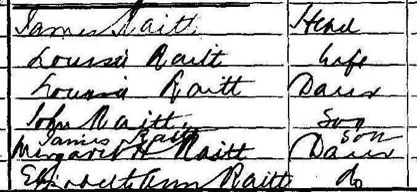The vagaries of records
The various ancestry websites offer different and/or selective information which is rather irritating! And this means that you have to double, even treble check details. I have been looking into the family back in Kincardineshire of a couple of Raitts who went to Australia. In census records on FindmyPast often the place of birth is not given - just the county, though it is on Ancestry (and ScotlandsPeople). So if you only check FindmyPast because you have a subscription and it is thus “free” to look at a record, then you miss vital information. So checking the 1891 census for James Raitt (given as Rait in the census) on FindmyPast we see that he was born in Forfarshire, his wife in Kincardineshire and his children either in Forfarshire, Kincardineshire or England. This is not as helpful as it could be, for in the Ancestry record - presumably taken from the same original census - we have the exact birth town given for James, his wife and the children born in Scotland. Furthermore, in FindmyPast, the header says the family is living in New Street, Dunnottar - this is misleading as the parish is Dunnottar, but the actual town is Stonehaven (which to be fair is given further down the record after all the names). But it shows how careful you need to be.
Now, in the Ancestry record for James Rait in 1891 there are three more names at the end of the list of people in the household - three children with the surname Walker. Were these children of James’s unmarried sister-in-law who is also in the household? They are, however, not given in the FindmyPast record for James. So which transcription is correct? It is necessary to check ScotlandsPeople - here you can view an image of the original census record, not merely a transcription as on Ancestry and FindmyPast. Well, it transpires that the last name on the page is the sister-in-law - so to see if the children are really in the household, it is necessary to pay additional credits to go to the next page. Well, they are not there at the top at all! Checking the names on FindmyPast, I found all three children safe at home with Mum and Dad and two other older siblings in Dunnottar (Stonehaven)! But for some reason these parents and older siblings are not found on Ancestry! And the reason is because the Ancestry transcriber must have turned over two pages at once and saw the three children at the top and the end of family line below the last name and assumed that they belonged to the page with James Rait’s family at the bottom. However the page after the entry for James and which the transcriber missed actually had the parents and two older siblings at the bottom of that page!
Now, I know that transcribers are supposed to put what they see rather than guess or know - and it is sometimes difficult to make out the original handwriting (is it Louisa or Louise, for example). But, in the 1901 census on FindmyPast, the occupation of James Raitt is given as horse hirer, while on Ancestry it is given as horse driver! Well, that’s not a million miles apart, but in the interests of accuracy and pedanticism then it is probably necessary to check on ScotlandsPeople and waste more credits. In fact, it is a little difficult to read - it does look like horsehirer - all one word. However, what is interesting in that image though - which is not at all apparent in the transcripts on FindmyPast and Ancestry is that the name and details of son James have been squeezed in (in smaller letters) between older John and younger sister Margaret H! He doesn’t get a line all to himself! And that yields yet another fact - son Robert does not appear on this page, but at the top of the next! That’s the annoying thing about ScotlandsPeople - you have to pay to look at two pages for one family in the census because they don’t have a subscription-based system like Ancestry and FindmyPast.
caveat emptor!
Sunday 31 March 2019

